Today I am going to look at ways to bypass the single lock of handcuffs. To do this it will be necessary to briefly describe the mechanism we will be dealing with.
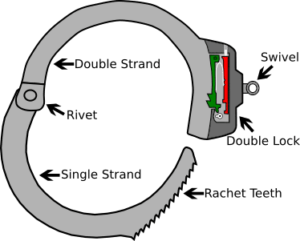
A typical pair of modern handcuffs uses a very simple mechanism. As you can see, the shackle/ strand (the moving part) has ratchet teeth. The teeth are engaged by the teeth on the pawl (green part) within the mechanism. The pawl allows the shackle to move in but not be pulled out. In “single-lock” mode the handcuff can be tightened but not loosened. The handcuff key engages the pawl directly and lifts it up, disengaging the teeth and allowing the shackle to be opened. Note that the pawl is under spring tension so will drop if the pressure from the key is removed.
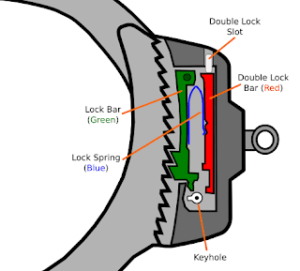
Above the pawl is a second mechanism (red). When this mechanism is engaged the handcuff is termed to be “double-locked” or “transport-locked”. When double-locked the pawl cannot rise, even if the correct key is used on it. The shackle of a double-locked handcuff can be neither tightened nor loosened. I will deal with double-locked cuffs in more detail in a future post. Today it is sufficient to understand that the techniques I will describe only work on single-locked cuffs, not those where the transport-lock is still engaged.
One way to unlock single-locked cuffs is to raise the pawl, mimicking the action of a standard key. For most cuffs this is relatively easy since the key has a simple flag without any cut-outs or other distinctive features. A variety of items can be used instead of a key. Bulldog clips, of the type that are triangular in section and have separate wire handles are very good for this. Obviously, these can be found in office environments or in desks. A desk can provide a prisoner with a variety of items that can be used for escape! Remove one handle and use the hooked end in the keyway of the cuff. Transparent training cuffs are very useful to have available when learning these techniques. Be careful of putting too much pressure on the plastic face of a training cuff and damaging the keyway.

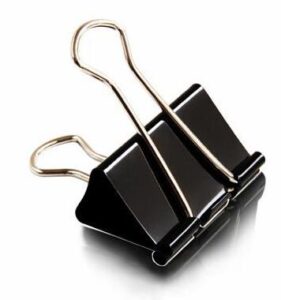
The second technique for single-locked cuffs is shimming. This may be attempted when you do not have something to use as a key or when the keyhole is difficult to reach. Probably the best way to learn shimming is with a hair pin, aka bobby pin. Transparent training cuffs are very useful here.
Take a bobby pin and pull the protective blob from the end of the straight side. Open the pin out and give the straight side a slight curve. Slide the straight end of the pin along the top of the ratchet teeth on the shackle and into the housing. The pin can go no further when it is up against the pawl. You now need to push the shackle inward while also applying gentle pressure to the shim. This will obviously tighten the cuff but human wrists can take a measure of compression. If you do this correctly the pawl will raise and the shim will slide between it and the shackle before the pawl can descend again. If your shim is sufficiently inserted the teeth of the pawl and the shackle will be separated by the shim and cannot engage. Keep moderate pressure on the shim and you should be able to pull out the shackle.
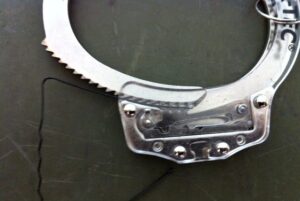
The chief merit of shimming is that a variety of items you may have on your person or in your surroundings can be turned into shims. If you do not have a bobby pin then a paperclip or various bits of wire can be used in the same fashion. Shims do not need to be metallic. Strips of card or plastic may be suitable. Strips of aluminium soda can seem too flexible but this might be solved by folding them. The material used for the can ends is thicker. One way to use a piece of can as a shim is to fold it into an inverted U-section shape. This may not be practical if the shackle is a tight fit within the housing. It may not be possible to slip the material between the side of the shackle and the inner wall of the housing. A large plastic drinking straw may be used as a shim in the same fashion. Be careful when handling strips of soda can. You can easily cut your fingers and the blood may make your escape attempt more problematic.
If you carry an escape kit then including some purpose-built shims is prudent. Some users carry quite a variety but in reality you need two types at most, with perhaps a bobby pin or wire for very narrow cuffs.
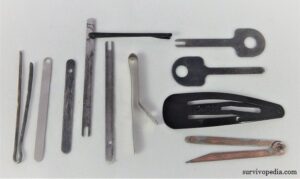
Commercially available shims tend to come in two forms. There are standard shims and “split” shims that have a notch in one end. Some handcuffs have obstructions intended to prevent shimming and the notched shim is supposed to counter this. The commercial notched shims I have seen only have a notch of a few millimetres depth. Some high security cuffs have obstructions that seem to be deeper than this.
Most commercial shims are made of steel. Some websites specify stainless steel but very few also provide the information as whether the stainless steel used is also non-magnetic. For an item such as a shim that you may want to conceal a low magnetic signature is an attractive feature.
While I was pondering this problem I discovered the turning tools I had made from laboratory spatulas were not magnetic!
Like many items of scientific equipment, lab spatulas are often subject to massive mark-ups. Price may vary fiftyfold so shop around.
The spatula is slightly over 3.5mm width so needs to be narrowed down a little for use as a shim. Round the corners and bevel the ends a little while you are working on it. I chose to slot one end. I used the cut-off wheel of a Dremel for this, which is probably not the best (nor the safest!) tool for the job. Not the neatest job I have ever done but sufficient for illustrative purposes. Use abrasive paper on the shim to polish it and remove any rough edges. The shim should have a slight curve. Passing it through a handcuff’s mechanism a few times creates this.
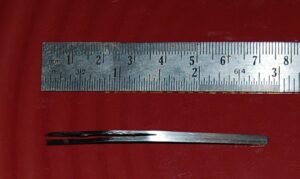
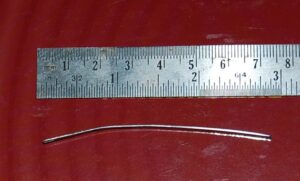
I don’t currently have any cuffs with anti-shimming features to test this shim against. It works very well on the training cuff and both the bifurcated and non-bifurcated ends can be used with this. The length of this shim lets me insert it across the full width of the cuff. This results in the handcuffs looking like they are secure but capable of being pulled open when desired.
Some cuffs use a narrower shackle as an anti-shimming measure so perhaps the non-bifurcated end should be narrowed even further. This would result in a tool that has an elongated Y-shape or that resembles a very slim tuning fork!
Many thanks to Shomer-tech for providing me with the transparent training cuff.